Back to the Home page
Duke of Burgundy, Hawnby Hill May 20th 2012
led by Keith Gittens
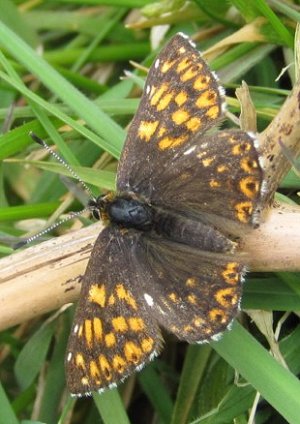 About a dozen members turned up on a rather cool, grey day more in hope than expectation of seeing any Duke of Burgundy butterflies. But we were wrong – they were there and we did see them, sometimes 3 at a time!
We met at the Moor Gate car park near Hawnby and Keith led us round the flank of Hawnby Hill to the steep rocky slopes on its west side where there is a mix of vegetation including numerous primroses which are very important as they (along with cowslips although those do not grow here) are the food plant for the Duke’s larvae. On the way we spotted this nice little patch of petty whin (Genista anglica) beside the path. One or two observant members thought they saw a green hairstreak butterfly.
About a dozen members turned up on a rather cool, grey day more in hope than expectation of seeing any Duke of Burgundy butterflies. But we were wrong – they were there and we did see them, sometimes 3 at a time!
We met at the Moor Gate car park near Hawnby and Keith led us round the flank of Hawnby Hill to the steep rocky slopes on its west side where there is a mix of vegetation including numerous primroses which are very important as they (along with cowslips although those do not grow here) are the food plant for the Duke’s larvae. On the way we spotted this nice little patch of petty whin (Genista anglica) beside the path. One or two observant members thought they saw a green hairstreak butterfly.
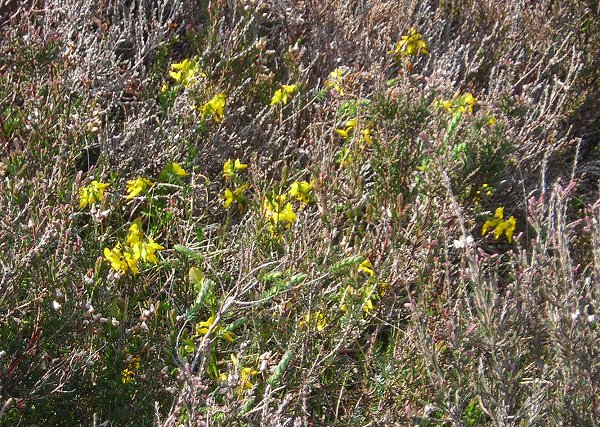
As we approached the butterfly site Keith reminded us of the importance of the habitat and reminded us not to trample the vegetation, especially the primroses. He explained the butterfly’s life cycle, which is essentially spend a few weeks as a larva (caterpillar) munching on the primroses, then to pupate and drop to the ground and spend the late summer, autumn and winter dormant down on the ground among the grass roots before emerging as a gorgeous adult that lives for a week or so with nothing more on its mind than mating and laying eggs on the fresh primrose plants. They need warmth and preferably sunshine to encourage them to fly. We were lucky in that the weather began to lift, and sure enough one or two insects started to move. They are much smaller than I imagined, barely an inch across, but absolutely stunning with orange and black patterns on the upperside and beautiful pale pearl-like markings on the underneath.
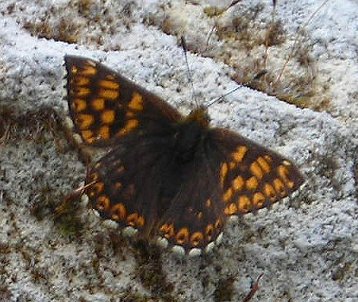
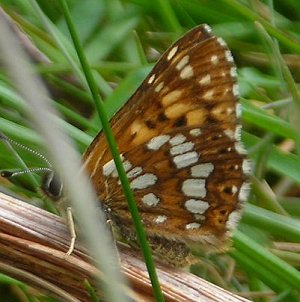
From a photographer’s perspective the weather was perfect, because it was only just warm enough for the Dukes to fly, and so they quickly landed and remained still while they soaked up a little more sunshine. Had it been warmer they would have been much more lively and very hard to catch on camera. You can see from the arctic gear it wasn’t exactly summery on the day (although later in the week it did turn hot and sunny and I believe there were far more butterflies on the wing.
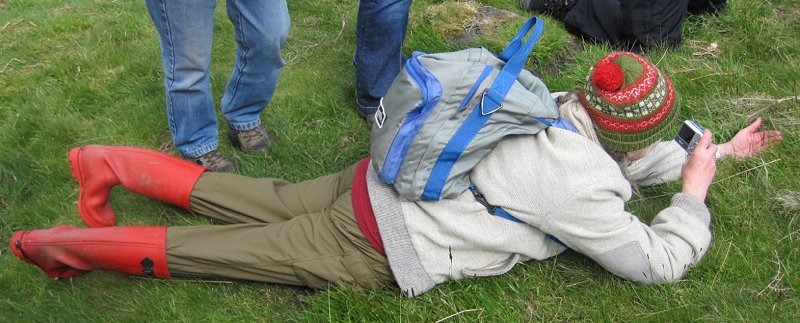
The flight is fast, buoyant, and dancing – we were lucky enough to see two or three together circling round in what may have been a territorial display. It is not easy to distinguish males and females although the latter are a little paler and have more rounded corners to the upper wings. As they landed we had to keep a very sharp eye on them as the camouflage was remarkably good: avert your gaze and they vanish against the background of dead bracken stalks and grass. They also showed a tendency to close their wings and hang vertically below a twig or bit of bracken which made them completely invisible from above! They weren’t easy from the side either....
We met a couple of other people who had come to visit the site, including Dave C with a very impressive-looking camera. He takes fantastic close-up shots of insects, and has kindly sent us a couple of his shots which are shown at reduced size – please visit his Flickr site to see his photos in all their glory (e.g. http://www.flickr.com/photos/39783429@N07/7233608604/in/photostream/).
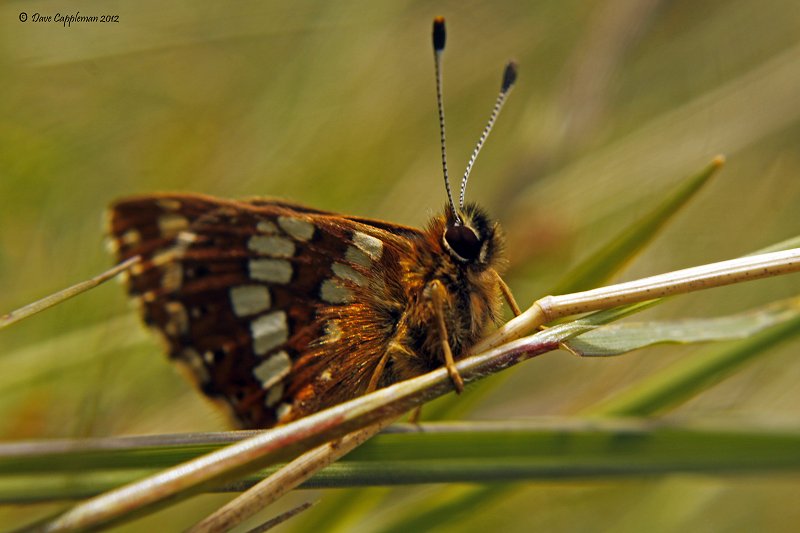
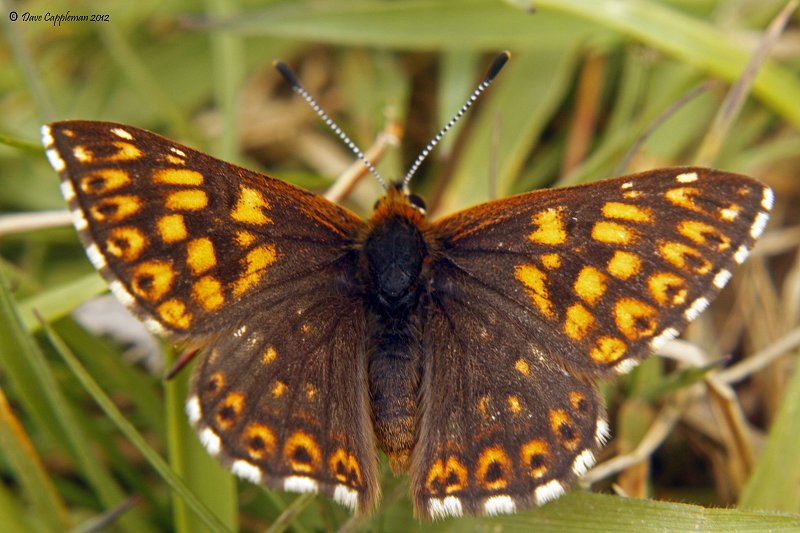
After a couple of hours stalking and photographing these beautiful rare butterflies we walked down to the river bank in the hope of seeing pied flycatchers. On the we were treated to a fine view of a singing male redstart. There were no flycatchers in evidence, but we did see relatively fresh otter spraint under the footbridge and on bankside rocks further along. We also saw a nuthatch at its nest hole and could clearly see the way the entrance had been “bricked up” with mud. As we walked back through the woods we heard many different birds including blackcaps, robins and willow warblers (full list below, thanks to Keith).
We returned to the cars mid-afternoon where we thanked Keith for a most enjoyable and informative day in the field.
Species lists
As this was specifically a butterfly trip I did not make a plant list, but the highlights were the petty whin at the beginning, bird cherry in full flower on the hillside, and bluebells putting on a good show in the woods. I am not aware of any other butterflies being seen but that may be because we were all concentrating so hard on the jewel-like Duke of Burgundy – a very special butterfly.
Birds
Cuckoo
Redstart
Willow Warbler
Chiffchaff
Blackcap
Tree Pipit
Meadow Pipit
Skylark
Grey Wagtail
Reed Bunting
Chaffinch
Bullfinch
Blue Tit
Great Tit
Marsh Tit
Coal Tit
Nuthatch
Tree Creeper
Goldcrest
Siskin
Wren
Robin
Mistle Thrush
Song Thrush
Swift
Swallow
Curlew
Golden Plover
Red Grouse
Lapwing
Jackdaw
Green Woodpecker
Greylag
| © Ryedale Natural History Society 2012 Photos © 2012 Dave Cappleman, Gill Smith, Jayne Smith |
Back to the Home page |
 About a dozen members turned up on a rather cool, grey day more in hope than expectation of seeing any Duke of Burgundy butterflies. But we were wrong – they were there and we did see them, sometimes 3 at a time!
We met at the Moor Gate car park near Hawnby and Keith led us round the flank of Hawnby Hill to the steep rocky slopes on its west side where there is a mix of vegetation including numerous primroses which are very important as they (along with cowslips although those do not grow here) are the food plant for the Duke’s larvae. On the way we spotted this nice little patch of petty whin (Genista anglica) beside the path. One or two observant members thought they saw a green hairstreak butterfly.
About a dozen members turned up on a rather cool, grey day more in hope than expectation of seeing any Duke of Burgundy butterflies. But we were wrong – they were there and we did see them, sometimes 3 at a time!
We met at the Moor Gate car park near Hawnby and Keith led us round the flank of Hawnby Hill to the steep rocky slopes on its west side where there is a mix of vegetation including numerous primroses which are very important as they (along with cowslips although those do not grow here) are the food plant for the Duke’s larvae. On the way we spotted this nice little patch of petty whin (Genista anglica) beside the path. One or two observant members thought they saw a green hairstreak butterfly.




